Infrared radiation can help rebuild your damaged nerves through targeted light therapy. When applied to affected areas, near-infrared light penetrates deep into your tissues and stimulates cellular repair mechanisms. It works by boosting ATP production in your cells, increasing blood flow, and reducing inflammation – all essential factors in nerve regeneration. You'll find this treatment particularly effective when combined with proper medical care, as it enhances your body's natural healing processes. While it won't cure all nerve damage instantly, research shows promising results for accelerating nerve repair and reducing pain. Understanding the science behind this therapy reveals even more exciting benefits for nerve regeneration.
Understanding Nerve Damage
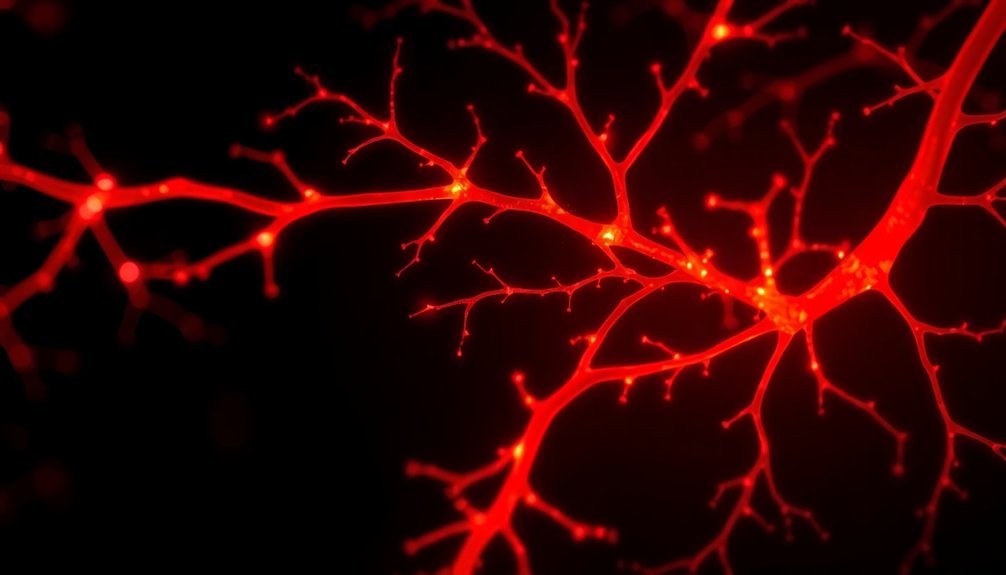
Vulnerability of our nervous system extends far beyond simple injuries, encompassing a wide range of potential damages from various sources.
You'll find that nerve damage can stem from chronic conditions like diabetes, which causes swelling that compresses blood vessels, or from infectious diseases such as HIV/AIDS, Lyme disease, and hepatitis C. Even your nutritional status, particularly vitamin B12 levels, plays a vital role in maintaining nerve health.
When you experience nerve damage, it can manifest in various ways. If your sensory nerves are affected, you might feel burning sensations, tingling, or numbness. Damage to your motor nerves can lead to muscle weakness, involuntary twitching, or even paralysis. Severe cases often result in sympathetic function loss.
The impact on your daily life can be significant, as nerve damage often affects your mobility and sensation.
You should know that nerve injuries can occur through different mechanisms. While stretch-related injuries are most common, you can also experience nerve damage through mechanical compression, lacerations, or exposure to radiation and extreme cold.
The severity of your symptoms will depend on whether the damage affects a single nerve or multiple nerves, and some cases may unfortunately be irreversible.
How Infrared Light Works
Infrared light reaches deep into your tissues, passing through layers of skin to stimulate damaged cells and promote healing at the cellular level.
You'll find near-infrared wavelengths are particularly effective, as they penetrate further than other forms of light therapy while triggering the release of nitric oxide, a key molecule for nerve regeneration. The therapy provides proven benefits by raising body temperature safely by about one degree centigrade.
Your body responds to this deep-reaching light therapy through increased cellular energy production and enhanced blood flow, which directly supports the repair of damaged nerve tissue.
Penetration Powers Cell Healing
Light's remarkable journey through human tissue sets the stage for powerful cellular healing. When infrared light penetrates your skin, it can reach depths of up to 1.5 inches, interacting with muscles, joints, and organs.
The key to this healing process lies in your mitochondria, where cytochrome C oxidase absorbs the light at specific wavelengths between 600-1,200 nm.
Your cells respond to this light exposure by ramping up their activity. You'll find increased cellular proliferation, especially in fibroblasts within your basal epidermal and subcutaneous layers. This process is enhanced through fibroblast activity stimulation, which accelerates tissue repair and healing.
The light triggers the production of reactive oxygen species and nitrogen species, while activating vital genes that promote healing. Your blood circulation improves, delivering more oxygen and nutrients to damaged areas.
In nerve tissue specifically, infrared light-emitting diodes enhance regeneration by boosting mitochondrial oxidative metabolism. They'll increase antioxidation levels in the chamber fluid surrounding nerve stumps, where neurotrophic factors help accelerate axonal growth.
The light suppresses early inflammatory responses and oxidative stress while stimulating the production of growth factors, creating ideal conditions for nerve repair and regeneration.
Deep Tissue Light Delivery
The healing journey of deep tissue therapy begins with precisely calibrated wavelengths between 700 to 1,000 nanometers. When you receive infrared therapy, specific wavelengths like 805nm, 810nm, 980nm, and 1064nm penetrate your tissues at different depths, each targeting distinct therapeutic needs. Near-infrared light proves especially effective at reaching deep tissue layers where nerve damage often occurs.
As the light enters your body, it interacts with tissues through three main processes: absorption, reflection, and scatter. The key action happens when your cells' mitochondria absorb the photons, triggering photochemical changes that boost ATP production and release beneficial compounds like reactive oxygen species and nitric oxide.
You'll typically receive this therapy through Class IV lasers, which deliver high-power output through either pulse wave or constant wave photobiomodulation. The pulse wave method often works better for reaching deeper tissues.
Your healthcare provider will choose the delivery method based on your specific condition and treatment goals. This targeted approach helps stimulate nerve regeneration, reduce inflammation, and relieve chronic pain conditions like peripheral neuropathy and sciatica by enhancing oxygen circulation and promoting muscle relaxation.
Nitric Oxide Release Process
Understanding nitric oxide release begins with a fascinating molecular dance triggered by near-infrared light. When NIR light hits specific molecules called NO donors, it starts a controlled decomposition process that releases nitric oxide.
You'll notice this change visually as the normally white NO donors transform to a wine-red color, indicating the formation of BHA molecules and NO.
The process is remarkably precise – you can control it simply by switching the NIR light on or off. When you apply the light, it takes about 20 minutes for the fluorescence intensity to stabilize, showing that NO release has reached its peak.
What's particularly interesting is that you're not just limited to one mechanism. Far-infrared radiation can also increase NO production through a different pathway, involving the phosphorylation of eNOS and the activation of calcium-dependent proteins.
You'll find this process has significant implications for nerve repair. When NIR light triggers NO release, it creates a cascade of beneficial effects, including enhanced antioxidation levels in nerve regeneration chamber fluid and improved vascular function.
This controlled release system offers precise therapeutic potential for treating nerve injuries and promoting healing.
Science Behind Neural Regeneration
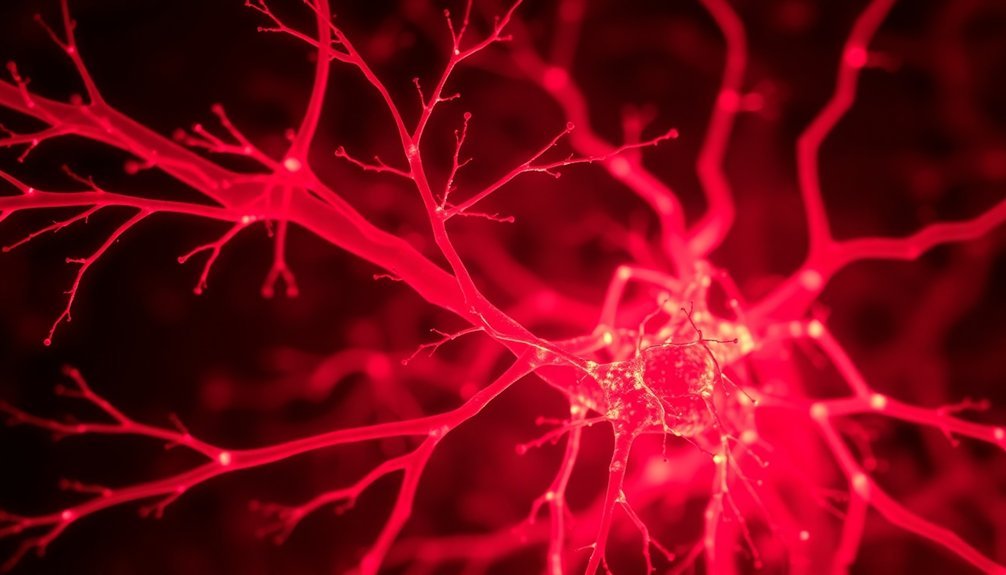
You'll find that infrared radiation enhances nerve regeneration by stimulating mitochondria to produce more ATP, your cells' primary energy source.
This energy boost activates cellular repair mechanisms and promotes neural growth while reducing inflammation in damaged nerve tissue.
Your body's nitric oxide levels also increase with infrared exposure, improving blood flow to injured nerves and accelerating the healing process through enhanced oxygen and nutrient delivery.
Mitochondrial Energy Production Pathway
Mitochondria's pivotal role in neural regeneration stems from their ability to generate the massive energy reserves needed for nerve repair. When you're looking at nerve cells, you'll find these powerhouses strategically distributed throughout neurons, particularly in areas demanding high energy.
They're constantly moving to where they're needed most, ensuring every part of the neuron has sufficient power for repair and regeneration.
Think of mitochondria as your nerve cells' power plants that need precise management. They shift from anaerobic glycolysis to oxidative phosphorylation to produce the substantial energy required for nerve regeneration.
When they're damaged or dysfunctional, you'll see local energy crises develop in neurons, which can severely hamper their ability to heal and regrow.
That's why your body has sophisticated systems to regulate mitochondrial activity. Through mitophagy, it removes damaged mitochondria while replacing them with healthy ones.
This process is essential because damaged mitochondria don't just fail to produce energy – they can trigger inflammatory responses that worsen neural damage. By maintaining healthy mitochondrial function, you're supporting your nervous system's natural ability to repair and regenerate.
Nitric Oxide's Neural Impact
Beyond cellular energy production, the intricate process of nerve repair relies heavily on nitric oxide (NO), a molecular messenger that orchestrates multiple aspects of neural regeneration. You'll find NO playing vital roles through three different forms of nitric oxide synthase (NOS): neuronal, endothelial, and inducible, each contributing uniquely to the healing process.
When your nerves are injured, NO steps in to promote healing in several ways. It enhances blood vessel formation and dilation at the injury site, helping remove cellular debris and allowing inflammatory cells to reach damaged areas.
You'll see NO's impact in the re-establishment of neuromuscular junctions and the recruitment of essential repair cells from your bloodstream.
However, you should know that NO's role is delicate. While it's essential for nerve regeneration, too much NO can become toxic to your neural tissues. That's why your body carefully regulates its production.
Scientists are now exploring therapeutic applications, including NO-releasing nanoparticles, to enhance nerve repair. They're finding that carefully controlled NO delivery could boost axonal regeneration and improve functional recovery after peripheral nerve injuries.
Blood Flow and Healing
Maintaining adequate blood flow plays a fundamental role in nerve repair through the process of angiogenesis, where new blood vessels form from existing ones. When you experience nerve injury, these new blood vessels create a specialized scaffold within the wound, establishing an environment that's essential for nerve regeneration.
Angiogenesis must be perfectly balanced – too little vascularization leads to chronic wounds, while excessive growth creates disorganized, leaky capillaries that can cause fibrosis. The newly formed blood vessels guide the development of mesenchymal tubes, which aren't present in healthy nerves but provide necessary pathways for regenerating nerve fibers.
Your nerve's blood flow directly impacts its healing potential. When nerves are damaged, they often suffer from poor vascularization, but techniques like low-level light therapy (LLLT) can help stimulate blood vessel growth. LLLT, developed by NASA and FDA-approved, uses red and near-infrared wavelengths to enhance blood flow and promote nerve regeneration.
It's worth noting that nerve blood flow decreases with tension, and ideal healing occurs when elongation is kept under 8%, as greater stretching can compromise recovery.
Cellular Response to Light
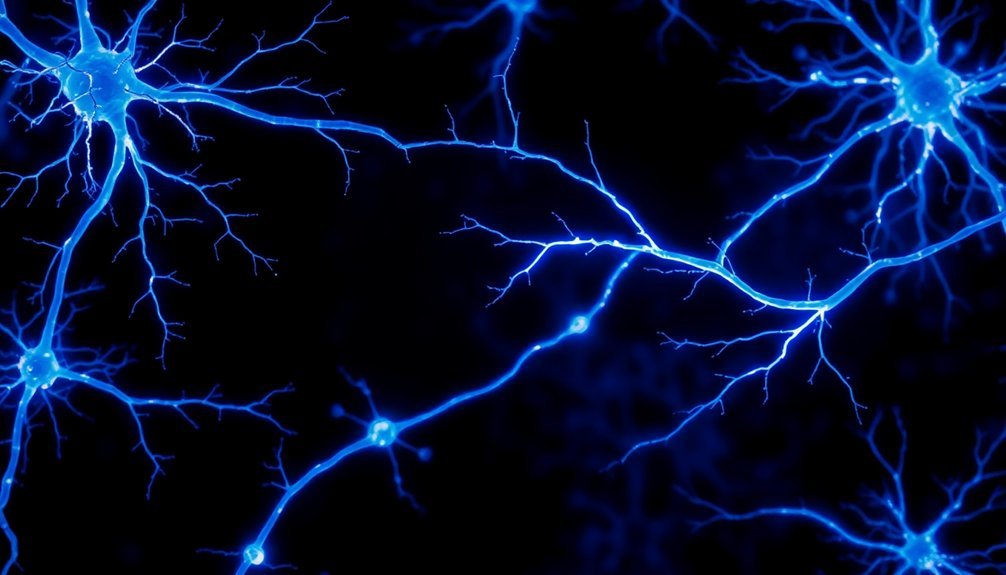
Cells demonstrate remarkable responses to light through specialized molecules called chromophores, which act as cellular light sensors. When light hits these molecules, they undergo specific structural changes that trigger various cellular processes, particularly in response to infrared radiation.
When infrared light reaches nerve cells, it stimulates their mitochondria to produce more ATP, virtually supercharging their energy production. This boost in cellular energy isn't just a minor effect – it's vital for nerve regeneration and repair.
The light also activates important signaling pathways that help cells survive and grow while suppressing harmful processes that could lead to cell death.
What's particularly interesting is how specific the wavelength requirements are. Your cells respond best to infrared light in the 800-1100 nm range, as these wavelengths can penetrate deep into tissues.
When nerve cells receive this specific type of light, they don't just produce more energy – they also increase their antioxidant levels and activate repair mechanisms. These cellular responses work together to create an environment that's highly conducive to nerve regeneration and healing.
Clinical Evidence and Research
Research shows you'll find compelling evidence for infrared therapy's effectiveness in nerve repair through multiple clinical trials and controlled studies.
You can see significant results in both far-infrared and near-infrared wavelengths, with studies demonstrating accelerated nerve regeneration, reduced pain, and improved muscle recovery compared to non-treated groups.
Clinical trials specifically highlight success rates in treating chronic low back pain and neuropathy, with wavelengths of 660nm and 980nm proving particularly effective for nerve regeneration and pain reduction.
Latest Research Findings
The latest scientific findings have revealed remarkable breakthroughs in understanding how infrared radiation affects nerve repair and regeneration. Researchers have identified specific wavelengths between 600-980 nm in the red to near-infrared spectrum that substantially enhance nerve regeneration through improved mitochondrial function.
Studies show that infrared radiation works at the cellular level by activating cytochrome C oxidase in mitochondria, which boosts ATP production and cellular metabolism. You're looking at a therapy that triggers multiple healing mechanisms: it increases synaptogenesis, promotes neuronal repair, and stimulates neurogenesis through the activation of early response genes.
What's particularly exciting is how infrared radiation can be combined with other treatments. Scientists have found promising results when integrating this therapy with biomaterials and traditional Chinese medicine techniques.
The treatment's non-invasive nature means you won't need surgery, and it can penetrate deep into muscle tissues to address nerve damage directly. Current research also indicates that infrared radiation reduces neuroinflammation and prevents neuronal cell death, while simultaneously promoting the production of essential neurotrophic factors for nerve growth and repair.
Clinical Trial Results
Building on these promising scientific discoveries, clinical trials have now validated the therapeutic potential of infrared radiation for nerve repair. You'll find that studies consistently demonstrate improved recovery times and enhanced functional outcomes when infrared therapy is applied to damaged nerve tissue. Research shows particularly encouraging results in treating chronic pain and inflammation, with patients experiencing significant relief through both transcutaneous and direct delivery methods.
| Treatment Approach | Key Findings |
|---|---|
| Transcutaneous Delivery | Safe, non-invasive, limited penetration depth |
| Implantable Devices | Precise targeting, better dose control, requires surgery |
| 660nm Wavelength | Effective for superficial nerve repair |
| 808nm Wavelength | Better tissue penetration, suitable for deeper injuries |
While you'll be encouraged by these results, it's important to understand the current limitations. The NEST trials revealed challenges in achieving adequate penetration through the human skull, highlighting the need for improved delivery methods. Additionally, while safety profiles remain excellent with minimal side effects reported, standardizing treatment protocols remains a key challenge. Current evidence suggests that early intervention with infrared therapy can accelerate nerve regeneration, though ideal dosing parameters are still being refined through ongoing clinical research.
Treatment Success Rates
Clinical evidence from groundbreaking studies reveals impressive success rates for infrared radiation therapy in nerve repair treatments. You'll find that 660nm light treatments have shown a remarkable 45% increase in cell viability over just five days of application.
When it comes to nerve regeneration and repair, the results are particularly encouraging, with significant improvements in both nerve cell survival and growth patterns.
The success of infrared radiation therapy is evident through multiple clinical indicators that you can observe:
- Enhanced functional recovery with daily one-minute doses of 660nm light over a seven-day period
- Substantial reduction in tissue scarring at injury sites
- Improved muscle action potential measurements compared to control groups
- Accelerated recovery timeframes with better quality nerve regeneration
- Increased antioxidation levels promoting ideal healing conditions
You'll see that these success rates are backed by clear biological mechanisms, including stimulated cytochrome c oxidase activity and increased nitric oxide production. The therapy's effectiveness is particularly significant in promoting mitochondrial oxidative metabolism and protecting against cell damage.
With standardized dosing through implantable devices on the horizon, you can expect even more precise and reliable treatment outcomes in the future.
Treatment Duration and Frequency
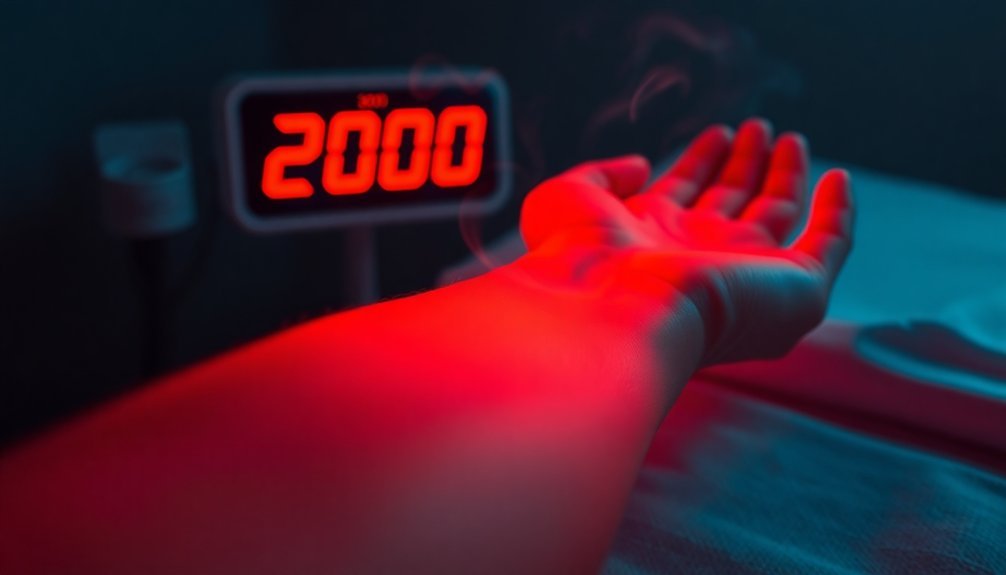
Successful infrared radiation therapy for nerve repair depends on three key timing factors: session length, treatment frequency, and overall duration. You'll typically undergo sessions lasting 10-15 minutes, though some treatments may extend to 30 minutes for whole-body exposure. For nerve regeneration and repair, you won't want to exceed these recommended durations to guarantee safety and effectiveness.
| Treatment Type | Duration | Frequency |
|---|---|---|
| Local Pain | 10-15 min | As needed |
| Spinal Cord | 1 min | Daily for 7 days |
| Muscle Recovery | 30 min | Post-injury |
| Chronic Pain | 10-15 min | Weekly |
| Neuropathy | 15 min | 2-3x weekly |
Your treatment frequency will vary based on your specific condition. For spinal cord injuries, you'll need daily one-minute sessions for a week, while chronic pain management might require weekly sessions. If you're using infrared therapy for muscle recovery, you can apply it immediately after injury or strain. The method of application matters too – you might receive treatment through direct application, whole-body exposure, or transcutaneous delivery, depending on your condition and treatment goals.
Safety Measures and Risks
While proper timing and duration are important aspects of infrared therapy, understanding safety measures can protect you from potential risks during treatment. You'll need to be especially cautious about protecting your eyes, as infrared radiation can cause retinal lesions, cataracts, and corneal burns. Always wear ANSI Z87.1-compliant protective eyewear during sessions.
If you're considering infrared therapy, you shouldn't proceed if you have certain conditions. These include impaired skin sensitivity, poor circulation, dermatitis, or metal implants. You'll also want to avoid treatment if you have fever, tuberculosis, or skin damage from radiation.
To guarantee safe treatment, you should implement these essential protective measures:
- Use barriers or curtains to control exposure levels
- Position light sources to prevent direct viewing
- Maintain appropriate room temperature, as it affects how you perceive the radiation
- Watch for signs of thermal burns or discomfort
- Stop treatment immediately if you experience unusual sensations
Remember that while infrared therapy can be beneficial, it's not suitable for everyone. Always consult a healthcare professional before starting treatment, and guarantee your provider follows proper safety protocols during each session.
Recovery Success Rates
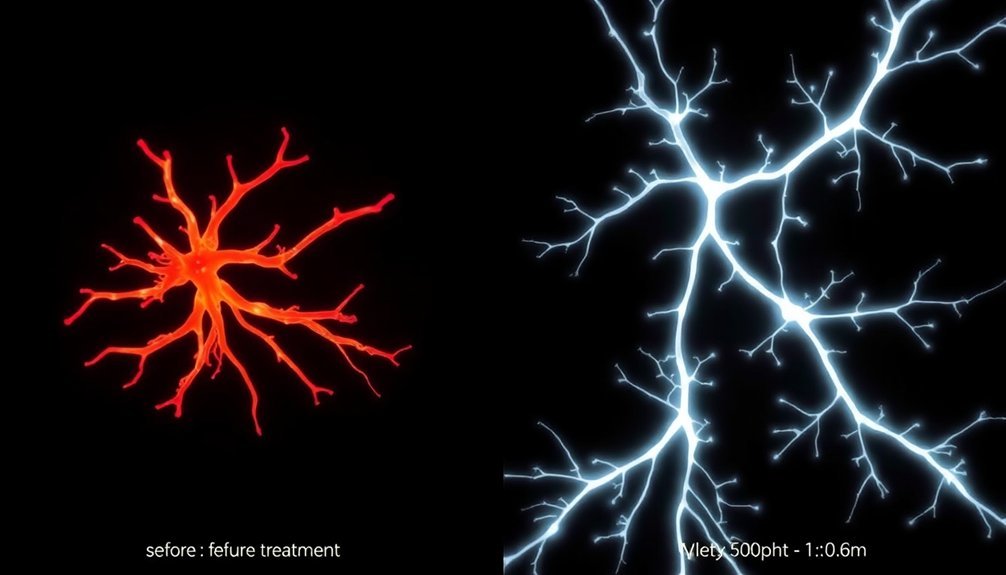
Promising research from preclinical models demonstrates that infrared radiation therapy achieves significant nerve regeneration rates, with studies showing improved functional recovery and enhanced sensory responses.
You'll find that success rates are particularly encouraging when ideal dosing regimens are followed, leading to increased cell viability and substantial nerve regrowth.
The therapy's effectiveness stems from its ability to stimulate multiple healing mechanisms. You can expect enhanced mitochondrial activity and increased antioxidant levels in the treatment area, which directly contribute to better recovery outcomes.
Both transcutaneous and implantable delivery methods have shown comparable success rates, giving you flexibility in treatment options.
While human clinical trials are still in development, you'll be interested to know that infrared light therapy's success in other medical applications, such as dermatological and oral treatments, suggests promising potential for nerve regeneration.
The therapy's dual action of neuroprotection and neuroregeneration means you're not just preventing further damage but actively promoting healing.
Current data indicates that when combined with proper surgical intervention, you can achieve better recovery outcomes through reduced tissue scarring and improved functional restoration.
Complementary Treatment Options
Beyond the established benefits of infrared radiation therapy, you'll find several complementary treatments that can enhance nerve repair outcomes. When you combine infrared therapy with other treatment methods, you're maximizing your potential for recovery while minimizing risks.
Unlike traditional pain medications that can be addictive, infrared therapy offers a natural, non-invasive approach that works effectively alongside other treatments.
You'll see the best results when you incorporate infrared therapy into an extensive treatment plan. The therapy's ability to stimulate ATP production and promote cellular regeneration makes it particularly valuable when combined with other healing modalities.
You can safely use it with physical therapy, medication, or other prescribed treatments to accelerate your recovery process.
- Combines effectively with physical therapy to enhance circulation and reduce inflammation
- Works synergistically with other pain management techniques without drug interactions
- Promotes faster healing when used alongside traditional medical treatments
- Complements exercise programs by reducing pain and improving mobility
- Enhances the effectiveness of rehabilitation protocols through improved tissue repair
The clinical evidence supporting infrared therapy's role in nerve regeneration continues to grow, making it an increasingly valuable component of in-depth neuropathy treatment plans.
Frequently Asked Questions
Can I Use Infrared Therapy While Taking Nerve Pain Medications?
Yes, you can safely use infrared therapy while taking nerve pain medications. There aren't any known contraindications, and it might even help reduce your need for medication. Still, consult your doctor first.
How Long After Nerve Injury Should I Wait Before Starting Infrared Treatment?
You don't need to wait to start infrared therapy after nerve injury. You can begin treatment immediately, but always consult your healthcare provider first to confirm it's appropriate for your specific condition.
Does the Effectiveness Vary Depending on Age or Overall Health Condition?
Current research doesn't show clear variations in effectiveness based on age or health. You'll likely benefit from infrared therapy regardless of these factors, though individual responses may vary. More research is still needed.
Can Infrared Therapy Help With Nerve Damage Caused by Dental Procedures?
Yes, you'll find infrared therapy effective for dental nerve damage. It'll help reduce pain, promote nerve regeneration, and improve healing in your oral cavity after dental procedures like implants or root canals.
Should Infrared Therapy Sessions Be Done Before or After Physical Exercise?
You'll get the best results by using infrared therapy both before and after exercise. Before workouts, it prepares muscles and improves circulation. After exercise, it helps reduce inflammation and supports muscle recovery.
In Summary
You've learned that infrared radiation shows promise in supporting nerve regeneration through increased blood flow and cellular repair mechanisms. While it's not a standalone cure, you'll find it can be an effective part of your recovery plan when combined with other treatments. You'll need patience, as healing takes time, but research indicates that consistent, proper infrared therapy may help rebuild damaged nerves under professional supervision.





Leave a Reply